wealthy

 Like it or not, people are put into classes based on their income, and as we know, the elite are the very rich ones. Most people fall into the middle class, with a large group of people being in the poverty level. Many of the people in these classes spend their time working hard and sometimes living paycheck to paycheck, just trying to make ends meet. While those people are doing their best to survive, the very wealthy, also known as the Elite Class spend their time doing their very best to outdo each other. What a headache that must be.
Like it or not, people are put into classes based on their income, and as we know, the elite are the very rich ones. Most people fall into the middle class, with a large group of people being in the poverty level. Many of the people in these classes spend their time working hard and sometimes living paycheck to paycheck, just trying to make ends meet. While those people are doing their best to survive, the very wealthy, also known as the Elite Class spend their time doing their very best to outdo each other. What a headache that must be.
During the Gilded Age, the Elite Class was in a particularly fierce fight for supremacy, not in politics or world economy issues, but rather in extravagancy. The Gilded Age took place from the 1870s to about the 1900s. During that time the Elite Class was building great estates with elegantly designed homes…trying to outdo each other while most Americans and Europeans struggled just to make basic ends meet. The Gilded Age elite struggled with one another, competing over who had the biggest, the most, the best…of any and everything. Anything that was outlandish, wild, shocking, or just plain spendy, was fair game in their “struggle.” The biggest source of extravagance was in their homes. Newport, Rhode Island, was prime real estate for the 19th-century one-percenters. Cornelius Vanderbilt constructed his famous 
 home, The Breakers, it was an attempt to one-up his brother, William K Vanderbilt’s latest showplace, Marble House, designed and planned by William K Vanderbilt to “outstaff, outdress, and outparty” his brother and other Gilded Age gents.
home, The Breakers, it was an attempt to one-up his brother, William K Vanderbilt’s latest showplace, Marble House, designed and planned by William K Vanderbilt to “outstaff, outdress, and outparty” his brother and other Gilded Age gents.
The whole production among the elites grew so fierce that home construction was covered in the local newspapers…on a daily basis!! The Newport Mercury reported that Marble House had 500,000 cubic feet of imported marble, as well as paneled walls portraying gods from the Classical age. Some walls were even coated in 22-carat gold leaf, all of it painstakingly applied by hand…not William K’s hand mind you. The latter Vanderbilt couldn’t sully his hands with the work of the common man. That was what his money was for…to underpay the common worker to build the elaborate house.
Yes, the whole age really was ridiculously extreme, but there was actually an ancient precedent that the Gilded Age families simply followed. Just take a look at the surviving Roman villas, the Versailles palace in France, and 
 the Catherine Palace in Saint Petersburg, Russia. The rich and powerful have always felt compelled to put their wealth on display. They did it to show other powerful people that they could keep up with the rest, and to challenge them to take the game to the next level…a challenge they happily accepted. It was a wild time, and in many places around the world, the game continues.
the Catherine Palace in Saint Petersburg, Russia. The rich and powerful have always felt compelled to put their wealth on display. They did it to show other powerful people that they could keep up with the rest, and to challenge them to take the game to the next level…a challenge they happily accepted. It was a wild time, and in many places around the world, the game continues.

 These days, people can buy a ticket to ride a train and have a private room with a bed and bathroom in it to make their trip more comfortable. Since I have taken a train trip from Seattle, Washington to Chicago, Illinois, I can tell you that paying the extra money for that private cabin is really a good idea. We traveled in in a seat among the other passengers, and while the seat was pretty comfortable, it was not comfortable to sleep in. My parents traveled on the Amtrack too, and they did get a private cabin, so their experience was probably much better than mine, although I loved the trip…just not the sleeping part of it. Of course, even with the comfort my parents had on
These days, people can buy a ticket to ride a train and have a private room with a bed and bathroom in it to make their trip more comfortable. Since I have taken a train trip from Seattle, Washington to Chicago, Illinois, I can tell you that paying the extra money for that private cabin is really a good idea. We traveled in in a seat among the other passengers, and while the seat was pretty comfortable, it was not comfortable to sleep in. My parents traveled on the Amtrack too, and they did get a private cabin, so their experience was probably much better than mine, although I loved the trip…just not the sleeping part of it. Of course, even with the comfort my parents had on 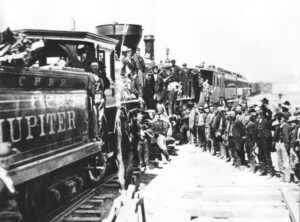 their trip, it was nothing compared to the Gilded Age, when the very rich had their own car on the train.
their trip, it was nothing compared to the Gilded Age, when the very rich had their own car on the train.
The Gilded Age was a time when the very rich went to great lengths to let all of the “less fortunate ones” know that they had wealth. The Gilded Age took place mostly from 1887 to 1900, with some earlier exceptions. One of the main objectives of life during the Gilded Age, if one could afford it, was to see and be seen in the most luxurious ways possible, and the railway was no different. Commercial air travel didn’t exist then, and cars were very slow. So, when the nation came into the age of the rails, the wealthy made sure that extreme luxury there was no exception. By the 1870s, private railroad cars…some extravagantly decorated…were the most fashionable way to travel. I suppose it would have been like the very 
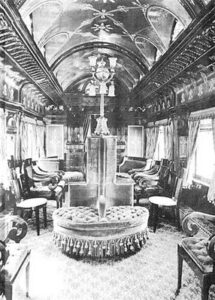 rich on ships, but they could stay a little closer to home, and still travel. The people would never travel in humble wooden coach seats, which I can understand, but most people had no other choice. Money bought comfort.
rich on ships, but they could stay a little closer to home, and still travel. The people would never travel in humble wooden coach seats, which I can understand, but most people had no other choice. Money bought comfort.
With great fanfare, the very rich boarded their own entire rail cars, where the walls were lined in velvet, the upholstery plush, and the decor much like that of a fancy parlor at home. The private cars had bedrooms, running water, and a private water closet. Now expense was spared to make sure that the wealthy car owner was never out of the lap of luxury. It seems like a cruel way to act, but I suppose it is simply the way it is.
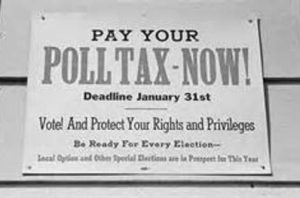 Those of us living today, might not have heard of a thing called a Poll Tax, but it was a very real thing, and with the election process just behind us, I think this might be something worth hearing. The Poll Tax was also known as a head tax or a capitation tax (meaning a tax for a head count). When I first thought about this particular tax, I thought well, maybe that kind of a tax could have ensured a fair election, but really, the opposite is true. While the head tax was considered an important source of revenue for many governments, from ancient times until the 19th century, in the United States at least; voting poll taxes (whose payment was a precondition to voting in an election) have been used to disenfranchise impoverished and minority voters (especially under Reconstruction). I find that absolutely unbelievable. In this nation in most election years, we have to practically beg people to get out and vote. Charging them money for it would all but insure a poor turnout. It would also insure that only those well enough off to be able to “throw money” at an election would be able to vote. Now that is truly appalling.
Those of us living today, might not have heard of a thing called a Poll Tax, but it was a very real thing, and with the election process just behind us, I think this might be something worth hearing. The Poll Tax was also known as a head tax or a capitation tax (meaning a tax for a head count). When I first thought about this particular tax, I thought well, maybe that kind of a tax could have ensured a fair election, but really, the opposite is true. While the head tax was considered an important source of revenue for many governments, from ancient times until the 19th century, in the United States at least; voting poll taxes (whose payment was a precondition to voting in an election) have been used to disenfranchise impoverished and minority voters (especially under Reconstruction). I find that absolutely unbelievable. In this nation in most election years, we have to practically beg people to get out and vote. Charging them money for it would all but insure a poor turnout. It would also insure that only those well enough off to be able to “throw money” at an election would be able to vote. Now that is truly appalling.
It is my understanding that originally the “poll tax” or maybe more correctly, head tax was not about an election, but more like the census. It even has Biblical roots…Mary and Joseph went to Bethlehem to be counted and pay their taxes to Caesar Augustus. This was the first of the head taxes. The tax might have been originally a way to bring in revenue. The poll taxes that followed, in most cases, were purely discriminatory. 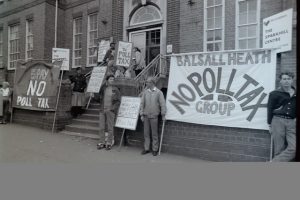 These latter poll taxes ensured that only wealthy people got the chance to cast their vote…thereby putting in candidates that those in charge wanted.
These latter poll taxes ensured that only wealthy people got the chance to cast their vote…thereby putting in candidates that those in charge wanted.
While the Poll Tax might have been a way to bring in money for governments, it seems to me that it could also be a way to make sure that the people vote for the candidate the government wants. Those who might have voted for change to improve the situation in their own neighborhoods, towns, cities, and states, were usually the poorer people, but they couldn’t vote for someone who could help, because they didn’t have the money. Many of these people were minorities. Head taxes were important sources of revenue for many governments from ancient times until the 19th century. In the United Kingdom, poll taxes were levied by the governments of John of Gaunt in the 14th century, Charles II in the 17th and Margaret Thatcher in the 20th century. By their very nature, poll taxes are considered very regressive taxes, are usually very unpopular and have been implicated in many uprisings.
On August 27, 1962, the Twenty-fourth Amendment (Amendment XXIV) of the United States Constitution was proposed. The Twenty-fourth Amendment prohibits both Congress and the states from conditioning the right to vote in federal elections on payment of a poll tax or other types of tax. The amendment was ratified by the states on January 23, 1964. When the 24th Amendment was ratified in 1964, five states still retained a poll tax. Those states were Alabama, Arkansas, Mississippi, Texas, and Virginia. These states continues the practice 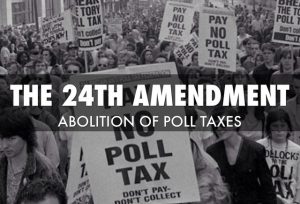 even though the amendment prohibited requiring a poll tax for voters in federal elections. Finally, in 1966 the US Supreme Court ruled 6–3 in Harper v. Virginia Board of Elections, that poll taxes for any level of elections were unconstitutional. The ruling stated that the poll tax violated the Equal Protection Clause of the Fourteenth Amendment. Further litigation related to potential discriminatory effects of voter registration requirements has generally been based on application of this clause. Those of us living today, might not have heard of a thing called a Poll Tax, but it was a very real thing, and with the election process just behind us, I think this might be something worth hearing. The Poll Tax was also known as a head tax or a capitation tax (meaning a tax for a head count).
even though the amendment prohibited requiring a poll tax for voters in federal elections. Finally, in 1966 the US Supreme Court ruled 6–3 in Harper v. Virginia Board of Elections, that poll taxes for any level of elections were unconstitutional. The ruling stated that the poll tax violated the Equal Protection Clause of the Fourteenth Amendment. Further litigation related to potential discriminatory effects of voter registration requirements has generally been based on application of this clause. Those of us living today, might not have heard of a thing called a Poll Tax, but it was a very real thing, and with the election process just behind us, I think this might be something worth hearing. The Poll Tax was also known as a head tax or a capitation tax (meaning a tax for a head count).
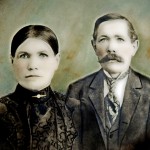 While it isn’t uncommon never to have met your great grandparents, I nevertheless, find it rather sad. Through my Great Aunt Bertha Schumacher Hallgren’s journal, I have heard so much about my Great Grandparents Schumacher, and in many ways I feel like I have known them all my life. When I look at the picture I have of them hanging on my living room wall, the faces seem familiar and welcoming to me. I feel like I know their personalities, likes and dislikes, and the struggles they had during their lives, and yet, I know the strength they had too, because through it all, they persevered. They raised a wonderful family of strong people who went on to lead successful lives and to raise wonderful children. Of course, the picture I have of them does not show smiling faces, because that was not really done in those days for photographs, but when I look into their eyes, I see a soft gentleness living there…a kindness, because that was the kind of people my great grandparents were. I know that from the words their daughter wroter about them.
While it isn’t uncommon never to have met your great grandparents, I nevertheless, find it rather sad. Through my Great Aunt Bertha Schumacher Hallgren’s journal, I have heard so much about my Great Grandparents Schumacher, and in many ways I feel like I have known them all my life. When I look at the picture I have of them hanging on my living room wall, the faces seem familiar and welcoming to me. I feel like I know their personalities, likes and dislikes, and the struggles they had during their lives, and yet, I know the strength they had too, because through it all, they persevered. They raised a wonderful family of strong people who went on to lead successful lives and to raise wonderful children. Of course, the picture I have of them does not show smiling faces, because that was not really done in those days for photographs, but when I look into their eyes, I see a soft gentleness living there…a kindness, because that was the kind of people my great grandparents were. I know that from the words their daughter wroter about them.

I know that my great grandfather loved horses, and worked hard caring for a rich landowner’s horses to earn the money to come to the new world, where he could have land and horses of his own. He had a dream, and he was bound and determined to make his dream come true…and he did. He succeeded so well, in fact, that his family thought he must be rich when he came to see him. I don’t think he considered himself rich, but his family was comfortable, and their needs were met. The children had a carriage to ride to school in, so they didn’t have to trudge three miles to school. The family had a sizeable place, and a number of horses, which shows me that my great grandfather fulfilled his dreams, and was a great provider for his family. He worked hard, and he wouldn’t have had things be any other way. He knew the value of what he had. Family was everything and he felt like his was the best one there ever was.
All these things I can get from pictures and from Bertha’s journal, but one of the most profound statements about her dad came when Bertha wrote, “HE LOVED HIS FAMILY!!” Her emphesis was so obvious. She typed it 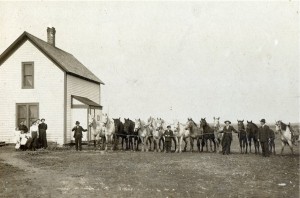 all in capital letters basically to show the world how strongly she felt about that statement. It wasn’t something she felt like she was obligated to write, but was rather, a statement from the heart. I think my grandfather was a kind and gentle man, who lovingly cared for his family, and especially his wife, who had Rheumatoid Artheritis for years. Nevertheless, he carried the load of the family with the help of his children, and that is a man I can’t wait to meet. My grandmother too was the kind of person who dealt with her pain with little complait, and raised a beautiful family in spite of it all. I look forward to the day when we will meet in Heaven, and I can sit down and really get to know these wonderful people.
all in capital letters basically to show the world how strongly she felt about that statement. It wasn’t something she felt like she was obligated to write, but was rather, a statement from the heart. I think my grandfather was a kind and gentle man, who lovingly cared for his family, and especially his wife, who had Rheumatoid Artheritis for years. Nevertheless, he carried the load of the family with the help of his children, and that is a man I can’t wait to meet. My grandmother too was the kind of person who dealt with her pain with little complait, and raised a beautiful family in spite of it all. I look forward to the day when we will meet in Heaven, and I can sit down and really get to know these wonderful people.
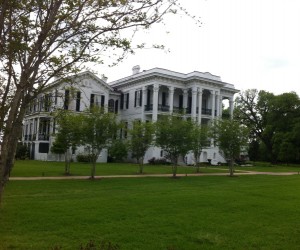 Bob and I are on a trip to Florida, Louisiana, Alabama, and Mississippi. It is a trip I have looked forward to for some time. As I have read through letters from the past and searched for past records for my family, it seems fitting that I should travel to an area of our country in which resides so much of our nation’s past. I don’t know if any of my ancestors were plantation owners or not, but I do know that some of them came from the south, so I suppose there is a possibility.
Bob and I are on a trip to Florida, Louisiana, Alabama, and Mississippi. It is a trip I have looked forward to for some time. As I have read through letters from the past and searched for past records for my family, it seems fitting that I should travel to an area of our country in which resides so much of our nation’s past. I don’t know if any of my ancestors were plantation owners or not, but I do know that some of them came from the south, so I suppose there is a possibility.
Going through Nottoway Plantation, gave us a peek into the lives of the very wealthiest plantation owners. These were people who could not “afford” to marry for love. Every child in the family knew what was expected of them. You married to better your standing and value…even if that meant marrying your cousin, as did happen in some cases, but was not totally common. Does this remind you of “Gone With The Wind”? It did us, but that is how the wealthy lived in those days, and maybe even more than we know in today’s world.
The Randolf family completed Nottoway Plantation in 1859 after 2 years of construction. It was situated right on the Mississippi River, and that was how the family traveled…by river boat, directly into New Orleans. They new no shortage of funds, and lived extravagantly…at least until the Civil War broke out in 1861. One of their sons was killed in the war, one became ill and was sent home, and one was captured. Still, the family proved what they were made of. The father, John went to Texas to grow cotton in order to make money, and the wife and some of the daughters stayed in the family home…even when the Yankee troops showed up. A wise woman, Emily offered to let the troops camp on her property and use what they needed. They took most of the vegetables and livestock, but left the home and the women alone…mostly because one of the soldiers knew one of the Randolf boys.
The home was made of the finest Virginia Cypress wood, which resisted rotting and termites, so the home has endured through the years. The shutters made of the same wood, are simply closed when hurricanes came, and the glass is even protected. The home is beautiful, and the family held many balls there as their children came of age for marrying, because they had to make sure that their children married from the right families.

While this family was wealthy and extravagant, they were also among the few families in the South who were good to their slaves. After the harvest and at Christmas time, John Randolf roasted a pig, and the family ate with the slaves. During that party, John handed out money to his slaves as a reward for jobs well done. Because of that, when the Civil War was over, and John offered contracts to his slaves, so they could now work for a wage, most of them stayed on with him. From the pay they had received through the years, they trusted him to keep his word and pay them after the war as well.
As I said, I don’t know if my family were plantation owners or not, but I like to think that if they were, they would be like John and Emily Randolf, who treated their slaves with kindness. I don’t like the idea of slavery, but I suppose that the people of that time didn’t know any different. It was a different culture, and as far as slaves are concerned, one that I think should not have happened, but unfortunately it is a part if our nation’s past.

